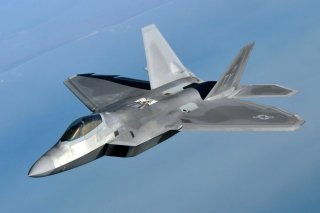Fight! Is Russia’s Su-57 Ready to Take On America’s F-22 Raptor?
Time will tell.
Here's What You Need to Remember: That means that if that whoever survives the beyond visual range engagement can meet in a visual dogfight. By the mid-2020s, both the Su-57 and the F-22 will be equipped with a helmet-mounted cueing system (HMCS) and highly capable high-off boresight (HOBS) air-to-air missiles, which basically allows the pilot to shoot in the direction he is looking.
The Lockheed Martin F-22 Raptor is the king of skies—it combines stealth and eye-watering kinematic performance with a power array of sensors weapons. For over a decade since the Raptor was declared operational in December 2005, the F-22 has been unquestionably the best air superiority fighter ever built.
But challengers are starting to appear. After emerging from its post-Soviet doldrums, Russia has developed a challenger to the mighty F-22 in the form of the Sukhoi Su-57 PAK-FA, which is scheduled to enter limited service in 2019. But does the Su-57 represent a genuine challenge to the Raptor?
Right now, the answer is no—the initial interim operational test versions of the Su-57 are powered by modified versions of the Su-35S Flanker-E’s engines called the AL-41F1, which produce about 33,000 pounds of thrust. The engine, which runs far hotter than the original AL-31 engines from which they were originally derived, is not proving to be as reliable as initially hoped. But the current engines are only temporary; a second stage version of the PAK-FA is expected to be powered by a new engine called the izdeliye 30, which should enter service in the mid-2020s. The new engine should produce roughly 42,000lbs of thrust, and—from an aerodynamic point of view—put the Su-57 on top, particularly when combined with the aircraft 3D thrust vectoring.
However, kinematic performance is not everything—even if the Su-57 might slightly edge out the Raptor once it receives its new engines. The F-22 will continue to retain the edge in terms of stealth over the Su-57, which only has a modest degree of radar cross-section reduction measures. Theoretically, with its powerful AN/APG-77 (V)1 active electronically scanned array radar, the F-22 would be able to see the Su-57 first and shoot it down with an AIM-120D AMRAAM or follow-on missile design before the Russian jet would even know it is under attack.
However, that is in theory—a theory that has never been put to the test. Russia has advanced electronic warfare capabilities—and its fighters are equipped with digital radio frequency memory (DRFM) jammers that can blind the AMRAAM’s active radar seeker. Moreover, while the Su-57 does incorporate some degree of forward sector radar cross section reduction, Moscow does not believe in stealth as a standalone survivability tool. The Russians prefer to use tried and true techniques such a beaming—or exploiting a pulse Doppler radar’s clutter notch to essentially disappear from enemy radar by turning 90 degrees to the direction of the enemy radar. That essentially makes the Su-57 appear as a stationary object relative to the enemy radar and is thus filtered out (pulse Doppler radar have a very difficult time with objects moving side to side). This is simply a matter of physics, there is very little an enemy can do to counter it except to adopt additional sensors—such as infrared search and track—and improve signal processing.
The Russians are hoping the Su-57 sensor suite—which includes N036L-1-01 L-band radar arrays—will alert its pilots to the general vicinity of enemy fifth-generation stealth fighters such as the Raptor. Tactical fighter-sized stealth aircraft must be optimized to defeat higher-frequency bands such the C, X and Ku bands as a matter of physics. Those aircraft show up on radar operating at longer frequency wavelengths such the L-band, however, the track is not precise enough to engage a target with a missile.
However, the L-band radar—part of the N036 Byelka radar suite—narrows the search area down so that the Su-57 can scan a smaller volume of space with its X-band N036-1-01 and N036B-1-01 active electronically scanned array apertures. The radar is further augmented with the 101KS Atoll electro-optical targeting system and the L402 Himalayas electronic countermeasure suite, which would help further refine a track from the L-band radar. The idea is that a focused search by the jet’s other sensors would result in a weapons quality track to engage a fifth-generation fighter such as a F-22. If the technique works, the Russians will have negated the Raptor’s stealth.
That means that if that whoever survives the beyond visual range engagement can meet in a visual dogfight. By the mid-2020s, both the Su-57 and the F-22 will be equipped with a helmet-mounted cueing system (HMCS) and highly capable high-off boresight (HOBS) air-to-air missiles, which basically allows the pilot to shoot in the direction he is looking. In the visual arena, victory will come down which aircraft is flown by the better pilots—and frankly luck. In training exercises between aircraft equipped with the AIM-9X and a HMCS, it has been demonstrated over and over again that when both jets are equipped with HOBS missiles, it often comes down to a “mutual kill.” Luck could be the determining factor.
Ultimately, the outcome of a Raptor versus Su-57 is an unknown. And it will likely remain an unknown for the foreseeable future.
This piece was first featured in 2018 and is being republished due to reader's interest.
Image: Flickr.

